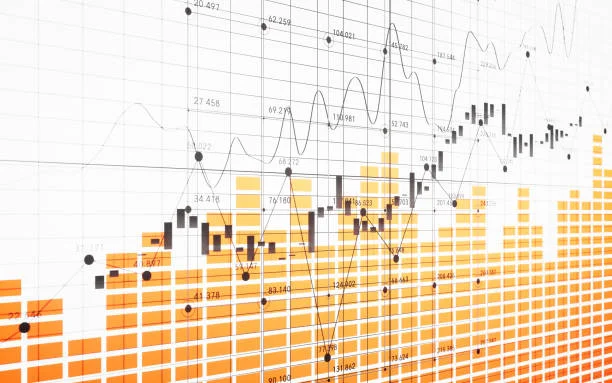High-frequency trading (HFT) can feel overwhelming with its speed and complexity. Did you know that quantitative analytics is the foundation of these ultra-fast trades? This blog will explain how data-focused methods help traders make split-second decisions to remain competitive.
Keep reading to explore the strategies behind the world’s fastest trades!
The Role of Quantitative Analytics in High-Frequency Trading (HFT)
Quantitative analytics informs decision-making in HFT by analyzing vast amounts of market data. Algorithms process numbers to identify patterns, price shifts, or anomalies faster than a blink.
Traders depend on these models to predict movements with high accuracy and execute trades instantly. For example, spotting a small price difference between two markets can activate arbitrage strategies for quick profits.
Speed isn’t the only critical factor; precision is equally important. Statistical tools evaluate risks and analyze market trends while machine learning improves predictions over time.
Experts note that firms using advanced data processing often outperform competitors who are slower to adopt new technologies. Quant insights also help traders adjust rapidly during volatile conditions, maintaining their sharp competitive edge.
In trading, information is power—and speed determines how much of it you control.
Core Quantitative Methods Utilized in HFT
Quantitative methods give traders a more precise advantage in high-frequency trading. They help identify patterns buried within extensive streams of financial data.
Statistical Models
Statistical models form the backbone of many high-frequency trading (HFT) strategies. Analysts use them to identify trends, predict price movements, and manage risks. These models rely on historical market data to reveal correlations or patterns that may not be immediately apparent.
Linear regression, for example, helps forecast asset prices by studying relationships between variables like volume and volatility.
Traders often apply autoregressive integrated moving average (ARIMA) models in predicting time series data such as stock prices. Options pricing relies heavily on statistical approaches like the Black-Scholes model.
By quantifying probabilities and uncertainties, these techniques provide insights critical for quick decision-making during trades. Machine learning builds upon these foundations by exploring predictive analytics and adaptive algorithms further.
Machine Learning Algorithms
Traders apply machine learning algorithms to process extensive quantities of market data instantly. These systems recognize intricate patterns that might escape human detection. They adjust rapidly, making them highly reliable for anticipating price changes and identifying trading opportunities.
Algorithms study historical data to enhance their precision over time. For instance, supervised learning models can predict stock prices by examining past trades and current market conditions.These approaches are equally useful for retail traders analyzing fast-moving equities such as penny stocks Robinhood, where machine learning helps identify momentum or breakout signals before larger market participants react.
In high-frequency trading, this combination of speed and precision allows firms to execute profitable strategies with remarkable efficiency.
Predictive Analytics
Predictive analytics expands on machine learning by anticipating future price movements. It processes historical market data and identifies possible trends or irregularities. Algorithms forecast short-term opportunities, enabling traders to respond before markets change.
This forward-looking method enhances profitability in high-frequency trading.
Advanced statistical models drive its predictions. These systems consider variables like liquidity, volume, and volatility all at once. For example, predictive tools might estimate a stock’s price direction within milliseconds after news is released.
As Dan Ariely says:.
Big data is about building insights you can act upon immediately.
Data Analysis and Decision-Making in HFT
Traders crunch massive amounts of market data to spot patterns and make split-second decisions that can mean the difference between profit and loss.
Processing Large-Scale Market Data
Machines process vast amounts of data from global financial markets every second. Algorithms evaluate stock prices, trading volumes, and order book changes with incredible speed. This assists traders in identifying opportunities within moments.
High-frequency systems depend on precise datasets to make immediate decisions. Servers handle this data close to the exchange, reducing delays caused by distance. These configurations help lower latency while ensuring trading signals stay dependable and timely.
Pattern Recognition for Trading Opportunities
Processing extensive market data helps identify recurring patterns. Recognizing these patterns enables traders to predict future price movements and make profitable decisions. For example, certain stock prices may consistently increase following specific economic events or announcements.
Identifying these trends can indicate when to buy or sell.
Traders often depend on statistical models and machine learning algorithms to detect opportunities promptly. Algorithms analyze historical data, searching for irregularities or repeated behaviors that suggest potential trades.
By acting swiftly on these insights, high-frequency trading systems take advantage of even small price changes within milliseconds.
HFT Strategies Driven by Quantitative Analytics
Traders rely on data-focused strategies to identify opportunities and maintain an advantage in the fast-paced world of high-frequency trading.
Arbitrage Strategies
Arbitrage strategies take advantage of price differences in assets across markets. These gaps result from inefficiencies in trading venues or timing delays. Traders apply quantitative analytics to recognize such discrepancies and complete trades within milliseconds.
Sophisticated algorithms oversee multiple exchanges for inconsistent prices. For instance, a stock might be priced at $100 on one platform but $99.80 on another. Purchasing at the lower price and selling at the higher price simultaneously secures small profits, which accumulate over thousands of transactions daily.
Mean Reversion Strategies
While arbitrage strategies focus on identifying price differences, mean reversion strategies take a different approach. These methods assume that asset prices tend to return to their average or historical levels after deviations.
Traders observe price movements and changes from the mean using statistical models.
A sudden rise in a stock’s price might indicate overpricing. On the other hand, a steep decline could suggest underpricing compared to its average value. Quantitative analytics allows for precise calculations of these averages and helps identify entry and exit points quickly.
High-frequency traders often rely on algorithms for swift execution when the reversion signals initiate trades. This method reduces holding periods and aligns well with HFT objectives of enhancing profit efficiency while lowering exposure to risks like market fluctuations during extended trade positions.
Momentum-Based Strategies
Momentum-based strategies focus on taking advantage of price trends. Traders identify assets moving quickly in either direction and profit from their movement. This approach depends largely on data analysis to detect patterns of acceleration within market activities.
Algorithms track variations in trading volume, price movements, and volatility. For instance, when a stock shows consistent increases over days or hours, algorithms execute buy orders to gain profits before a reversal occurs.
These strategies perform well in rapidly changing markets where trends influence short-term price behavior.
The Impact of Speed and Technology in HFT
Speed determines success or failure in generating profits in high-frequency trading. Sophisticated technology competes to execute trades faster than a blink.
Execution Latency and Profitability
Execution latency directly affects profitability in high-frequency trading. Trades executed a fraction of a second too late can miss ideal prices, leading to reduced gains or losses.
Every millisecond counts because markets shift rapidly as algorithms compete for the same opportunities.
Traders depend on low-latency systems to analyze and act faster than competitors. Sophisticated financial technology, such as co-location near exchange servers and fiber-optic connections, helps reduce delays.
Faster execution enhances the likelihood of success by capturing brief pricing inefficiencies before they vanish.
High-Speed Infrastructure
Trading firms invest significantly in advanced infrastructure to stay ahead of competitors. Fiber optic cables, microwave towers, and co-location services minimize transmission delays.
These technologies enable algorithms to send buy or sell orders in an instant.
HFT firms often position servers near stock exchanges to reduce latency. This closeness cuts milliseconds from trade execution times, which can determine profit or loss. Speed remains vital as traders pursue arbitrage strategies that depend on rapid data analysis and decision-making for success.
Risk Management Through Quantitative Analytics
Traders use quantitative analytics to identify potential risks before they escalate. Sophisticated models help them respond rapidly to changing market conditions.
Identifying Key Risk Factors
Analyzing market volatility can highlight sudden price changes that may reduce profits. High-frequency trading firms often face risks from unforeseen events, such as economic announcements or geopolitical tensions.
System failures also present significant dangers. An error in algorithms or hardware delays could lead to missed opportunities or costly mistakes. Monitoring execution speed and ensuring reliable systems helps mitigate these risks.
Implementing Advanced Risk Models
Traders develop sophisticated risk models to minimize financial losses. These models depend on statistical methods and predictive analytics to evaluate potential risks in milliseconds.
By examining price changes, trading volumes, and market irregularities, these tools pinpoint vulnerabilities that could endanger profitability.
Machines carry out actions based on predefined risk limits. For instance, if a security’s volatility surpasses acceptable levels, the system can halt trades automatically. This method safeguards accounts from escalating losses during unexpected events like flash crashes.
The Influence of Quantitative Analytics on Market Liquidity
Quantitative analytics sharpens how traders spot gaps in market liquidity. It drives smarter decisions by analyzing price movements and order flows at lightning speed.
Enhancing Market Efficiency
High-frequency trading accelerates market operations by enabling trades at lightning speeds. This rapid activity reduces bid-ask spreads, ensuring buyers and sellers agree more closely on price.
Faster transactions increase liquidity, making it easier to buy or sell assets without significantly affecting the price.
Algorithmic trading systems also detect pricing inefficiencies instantly. They adjust mispriced securities in a fraction of a second, bringing stability to markets. By processing massive data streams, these systems help ensure fairer prices across multiple exchanges globally.
As a result, traders experience smoother transactions with minimal obstacles in volatile conditions.
Managing Volatility
Quantitative analytics plays a crucial role in reducing market volatility. Traders rely on advanced models to examine price swings and predict rapid changes. These tools help recognize patterns, allowing for quicker response times during unstable market conditions.
Algorithms modify trading strategies based on real-time data inputs. For example, they can decrease trade volume when prices fluctuate wildly or increase it when markets stabilize.
This minimizes the risk of significant losses while maintaining efficiency, supporting effective liquidity management in high-frequency trading environments.
Ethical and Regulatory Considerations in Quantitative HFT
Ethical concerns arise when trading algorithms take advantage of market inefficiencies to the detriment of other participants. Strict regulations encourage firms to find a balance between earning profits and maintaining fair trading practices.
Addressing Unfair Market Practices
Traders face challenges when unfair practices like spoofing or layering disturb markets. Spoofing occurs when someone places fake orders to mislead others into reacting, only to cancel them after influencing prices.
Quantitative analytics assists in recognizing such deceptive patterns. Algorithms analyze large datasets in real time, detecting unusual order behaviors immediately. This prompt detection prevents manipulation from increasing and safeguards market integrity.
Compliance with Global Regulations
Regulators across the globe impose strict rules to maintain fairness in high-frequency trading. Quantitative analytics assists firms in adhering to these boundaries by monitoring trades in real time and identifying potential violations.
Algorithms can detect unusual price movements or find suspicious activities that might breach regulations.
Countries like the U.S., Japan, and those within the EU enforce different compliance frameworks for financial markets. Analytics-based systems adjust to each region’s laws, ensuring trades comply with specific market standards.
By continuously monitoring activity, firms minimize legal risks while fostering transparency in their operations.
Conclusion
Quantitative analytics drives the rapid pace of high-frequency trading. It assists traders in processing vast amounts of data and making immediate decisions. With the right strategies, it converts market patterns into profit opportunities.
While speed is crucial, careful risk management ensures trades remain controlled. This combination of math, technology, and precision influences modern markets daily.

